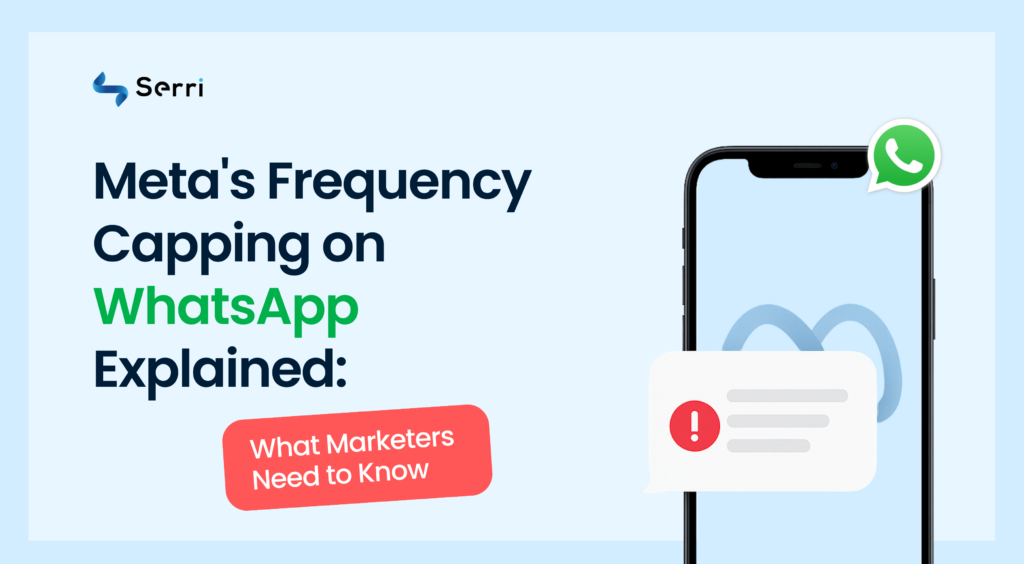
Meta has rolled out a key update for businesses using the WhatsApp Business API, Frequency Capping.
This new feature improves user experience by limiting the number of marketing messages a user can receive within a set period.
What is Frequency Capping?
Frequency Capping is a user-friendly feature that limits how many marketing messages a WhatsApp user can receive over 24 hours.
For instance, a user may only get messages from up to 15 different brands within 24 hours. Meta sets these limits dynamically and keeps them undisclosed to businesses to ensure a smooth and non-intrusive user experience.
Why Did Meta Introduce This?
Meta’s main aim is to protect users from feeling overwhelmed by too many marketing messages. By limiting the noise, it creates a better experience for users, and for businesses, it means their messages have a higher chance of being seen, read, and acted upon.
Which Messages Are Affected?
Frequency Capping applies only to marketing messages sent through WhatsApp Business API templates.
However, some message types are not affected:
Customer Service Messages: Any conversation started by the user and responded to within 24 hours remains uncapped.
Click-to-WhatsApp Ads: Messages triggered through these ads are still allowed without restriction.
Adapt Your Messaging Strategy
With Frequency Capping in place, businesses should rethink their approach to customer communication. Here are some ways to stay effective:
1. Get User Permission(Opt-in) Before Messaging
Before you start sending WhatsApp broadcasts, make sure users know what to expect. Mention on your website forms that their number might be used for WhatsApp updates. It’s a small step that helps build trust and avoids getting blocked, which means better delivery rates for you.
2. Don’t Immediately Resend Failed Messages
If a message doesn’t go through, don’t panic. Wait 4 to 6 hours before trying again. The user might have already received too many promotional messages that day.
If you’re using Serri, you can navigate to Campaigns → Select the campaign with failed contacts→ go to the ‘Failed’ section → and resend your broadcasts.
This simple retargeting step can boost your delivery rate by up to 50%.
3. Make It Easy to Opt Out
Always give people a way to stop receiving messages if they want to. It shows respect and also tells Meta that your business is playing by the rules.
With Serri, it’s easy to just let users reply with a keyword like “STOP” to opt out.
4. Balance Promotions with Engaging Content
Don’t make every message about selling. Mix in helpful tips, fun facts, or engaging updates. When users interact with your messages, Meta sees it as a sign of good quality, which can help your messages reach more people.
5. Avoid Sending Bulk Cold Broadcasts
Sending cold messages in bulk without permission is risky. It can get your number flagged, lower your quality rating, and reduce your reach.
Keep cold outreach limited and spend more effort engaging users who’ve already shown interest.
By embracing these practices, businesses can thrive in this new environment, keeping their outreach impactful, relevant, and customer-first.
FAQs
1. What is Frequency Capping on WhatsApp?
Frequency Capping is a new feature introduced by Meta that limits how many marketing and utility messages a user in India can receive, probably in 24 hours, through the WhatsApp Business API.
2. Why has Meta implemented this?
Meta wants to make sure users don’t feel spammed with too many messages. When users get fewer, more relevant messages, they’re more likely to pay attention, so businesses see better results.
3. Who is impacted by Frequency Capping?
Only users with Indian numbers (country code +91) are affected. The feature is currently specific to India.
4. Will this affect customer support messages or Click-to-WhatsApp (CTWA) ad responses?
No. Messages within an active session (like user-initiated support chats) and those triggered through CTWA ads are not subject to capping.
5. Which type of messages are capped?
Only new marketing template messages that start a fresh conversation are capped. If there’s already an ongoing marketing conversation, additional messages within that window won’t count against the cap.
6. What about messages that combine utility and marketing?
If your message includes marketing elements, even if it’s also partly transactional, it may be classified as marketing, and there is a risk of being blocked due to capping